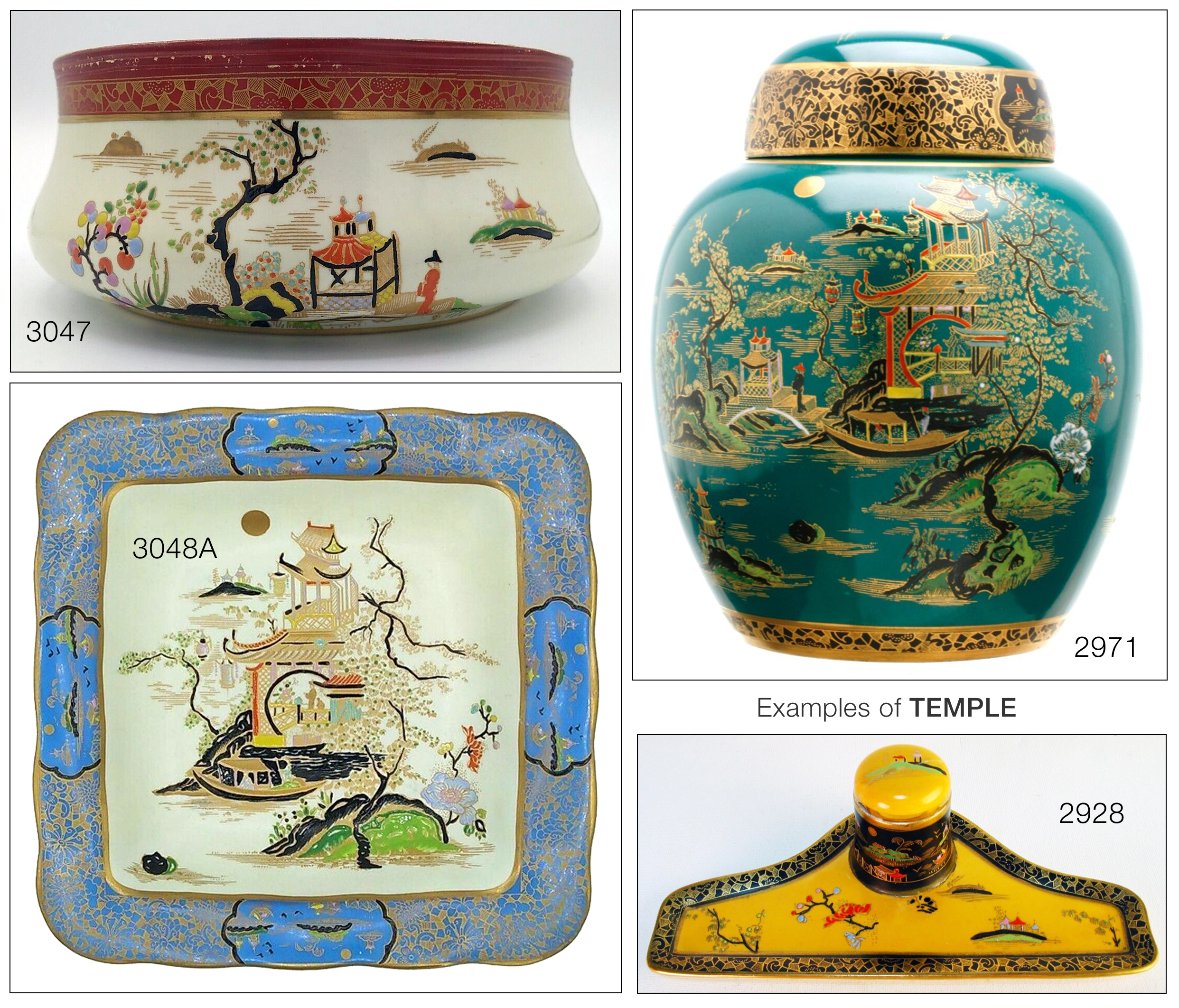
TEMPLE
Carlton Ware's TEMPLE pattern and its Borders
by Harvey Pettitwith border artwork by Barbara Anne Lee

TEMPLE was one of Horace Wain's last designs for Carlton Ware. I estimate that it was introduced in 1921, following on from his MIKADO pattern introduced a year earlier.
The first version employed a POWDER BLUE ground, as shown on the right. It was allocated the pattern number 2481. Although most of Wain's Chinoiserie patterns were either copied from or were reinterpretations of seventeenth or eighteenth century Chinese porcelain, I have not been able to identify any quite like his TEMPLE pattern. I suggest, therefore, that it is his invention unless its source is from another field. Clearly this well composed pattern is in the Chinese idiom.
Most variants used TEMPLE BORDER and/or TEMPLE BEAD to frame the pattern. Barb details these for us towards the end of this article. Some examples with the POWDER BLUE ground, however, use Wain's MIKADO BORDER as on the floating flower bowl shown on the right. Click or tap on the image to enlarge it to see the border more clearly.
Curiously, although introduced in 1921, TEMPLE was registered as a design in January 1927. The long delay is probably down to the discovery of copying, possibly by the Japanese—somewhat ironically.
Later variants by Enoch Boulton
The number of variants of TEMPLE was greatly extended by Enoch Boulton, Horace Wain's successor as designer and decorating manager. Though Wain was adventurous with his use of colour, Boulton was even more so, as you can see on some of Boulton's versions below. These employ two contrasting ground colours, one for the pattern and the other for the border.

Carlton Ware's pattern records list an astonishing fifty-two variants of TEMPLE introduced between 1921 and 1940, testament to the pattern's popularity. The highly decorative TEMPLE BORDER, which Barb shows us next, was used on its own and had ten variants. It would be quite a challenge to find all of these!

'prunus on cracked ice' jar.
Click or tap on the image to enlarge.
TEMPLE BORDER
The TEMPLE pattern employs two borders, one wide and the other narrow, called a bead. Both portray flowers set against a "cracked ice" background. On Chinese wares, cracked ice is associated with prunus blossom, their combination signifying the coming of Spring. On the right I show a jar from the Kang-Hsi period (1622-1722) with an example of that fusion; such compositions must have influenced Wain.
Carlton Ware's TEMPLE BORDER is interspersed with panels depicting a Chinese scene. Superimposed on the "cracked ice" background, Wain not only uses prunus blossom in the Chinese manner but also what appears to be chrysanthemum and lotus blooms. You can see this in Barb's fine rendition of the border below— click or tap on the image to see how the border looks on other grounds and with other patterns; use your back button to return to this page.

© Barbara Anne Lee 2023.
TEMPLE BEAD
Where it was moreappropriate to use a narrow border, Wain created TEMPLE BEAD, which Barb has redrawn for us below. With its narrow width, there is only space for only parts of prunus blossom and perhaps a petal from a chrysanthemum bloom against the "cracked ice" background—click or tap on the image to see how the border looks on other grounds. Use your back button to return to this page.

© Barbara Anne Lee 2023.
© Copyright Harvey Pettit.
V1a. First published June 2024.
The next series of articles are about patterns and their borders devised by Enoch Boulton (c1921-1930) that feature birds.
NOTE - To help you avoid mixing up pattern and shape names I use some simple typographic conventions. You can read them by clicking or tapping on the button on the left below.
Or